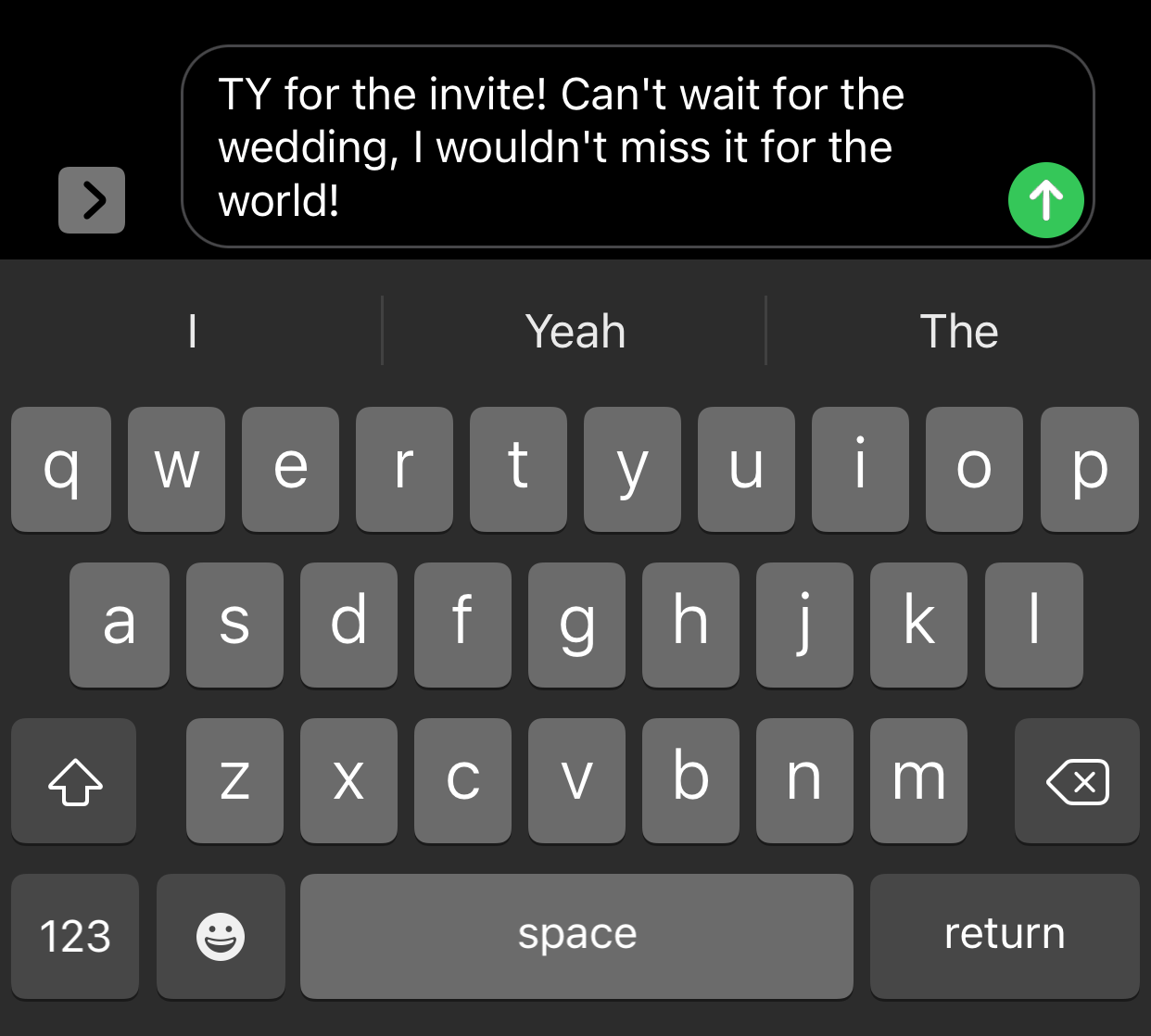Ty In Text Message: What It Really Means And How To Use It
Ever been in the middle of a text convo and someone hits you with "ty"? Hold up, what does that even mean? If you're scratching your head or pretending to know but secretly Googling it, you're not alone. TY in text message has become a shorthand staple in our fast-paced digital world. So let's break it down, shall we? This ain't rocket science, but it's definitely worth knowing if you want to keep your texting game on point.
In the land of abbreviations, ty stands out because it’s simple yet effective. Imagine texting someone a quick thank you without typing out the whole phrase – ty is your shortcut. It’s like the CliffsNotes version of gratitude, but don’t let its brevity fool you. This little two-letter combo packs a punch and can make your messages feel more casual and chill.
Now, before we dive deeper into the world of ty, let’s get one thing straight: using ty in text message isn’t just about being lazy. It’s about efficiency, staying cool, and keeping the conversation flowing smoothly. And trust me, once you master it, you’ll wonder how you ever lived without it. So grab your phone, fire up that messaging app, and let’s get into the nitty-gritty of ty.
- Does Derek Morgan Die Unveiling The Truth Behind The Popular Question
- Louis Litt The Charismatic Lawyer With A Heart Of Gold
What Does Ty Mean in Text Message?
The Basics of TY
So, what exactly does ty mean? Simply put, ty is shorthand for "thank you." It’s the texting equivalent of giving someone a quick nod of appreciation without all the formalities. Think of it as a verbal high-five in written form. And let’s be real, in today’s fast-paced world, who has time for long thank-you notes? Not me, and probably not you either.
Here’s the kicker: TY isn’t just limited to texts. You’ll see it pop up in emails, social media comments, and even in real-life conversations where people are trying to sound extra casual. The beauty of TY is its versatility. It works in pretty much any situation where you want to say thanks without overcomplicating things.
Why TY Became a Thing
Let’s rewind for a sec. How did TY even become a thing? Well, blame it on the evolution of language. As humans, we’re always looking for ways to communicate faster and more efficiently. TY fits perfectly into this mold. It’s quick, easy to type, and gets the job done without any fuss.
- Strawberry Tabby Cats The Cutest Feline Sensation You Need To Know About
- Sanford Airport Allegiant Terminal Your Ultimate Guide For Seamless Travel
Think about it: before TY, we had to type out the full "thank you," which, let’s face it, takes way too long sometimes. TY cuts that time in half, making it a no-brainer for anyone who values speed over formality. And in the world of texting, where every second counts, TY is like the MVP of abbreviations.
Common Misconceptions About TY
Is TY Too Casual?
One of the biggest misconceptions about TY is that it’s too casual for serious situations. Sure, TY might not be the best fit for a formal business email, but in most casual conversations, it works just fine. The key is knowing your audience. If you’re texting a close friend, TY is perfectly acceptable. But if you’re writing to your boss, maybe stick with the full "thank you."
Here’s a pro tip: context is everything. If you’re unsure whether TY is appropriate, consider the relationship you have with the person you’re texting. If it’s someone you’re on a first-name basis with, TY is fair game. But if it’s someone who demands a bit more formality, it might be worth skipping the abbreviation.
TY vs. TYVM: What’s the Difference?
Another common misconception is that TY and TYVM mean the same thing. While they’re both abbreviations for expressions of gratitude, there’s a subtle difference. TY stands for "thank you," while TYVM stands for "thank you very much." So if you want to add a little extra flair to your gratitude, TYVM is the way to go.
Here’s a quick breakdown:
- TY: Basic thank you
- TYVM: Extra thankful thank you
Choose wisely depending on how grateful you’re feeling at the moment. No one likes a thank-you overkill, but a well-placed TYVM can definitely brighten someone’s day.
How to Use TY Effectively
TY in Casual Conversations
Using TY in casual conversations is a no-brainer. Whether you’re thanking a friend for lending you their notes or appreciating someone for holding the door open for you, TY fits seamlessly into the flow of the conversation. Here’s how you can drop it into your texts:
- Friend: "Here’s the playlist I made for the road trip!"
- You: "TY! This is gonna make the drive so much better!"
See how smooth that was? No need for a long thank-you speech. Just a simple TY does the trick.
TY in Professional Settings
Now, let’s talk about using TY in professional settings. While TY might not be the best fit for formal emails, it can still work in casual office chats. For example:
- Colleague: "I sent over the report you requested."
- You: "TY! I’ll check it out ASAP."
Again, it’s all about context. If you’re working in a laid-back office environment where everyone uses abbreviations, TY is totally acceptable. But if you’re in a more formal setting, it might be worth sticking to the full "thank you."
The History of TY
Where Did TY Come From?
TY might seem like a modern invention, but its roots go back further than you think. The abbreviation likely originated from early internet chat rooms and instant messaging platforms. Back in the day, typing speed was crucial, and TY became a quick way to express gratitude without breaking the flow of the conversation.
As texting became more popular, TY naturally made its way into our mobile conversations. Today, it’s a staple in the texting lexicon, used by millions of people around the world. And honestly, who can blame them? TY is just so darn convenient.
TY in Pop Culture
TY hasn’t just stayed in the world of texting; it’s made its way into pop culture too. You’ll see it in TV shows, movies, and even music lyrics. It’s become a symbol of casual communication, representing the shift from formal to informal language in our daily lives.
Take a look at some of your favorite shows or movies. Chances are, you’ll catch a character using TY in a text or conversation. It’s become so ingrained in our culture that it’s hard to imagine a world without it.
TY Around the World
How Different Cultures Use TY
While TY might seem like a universal abbreviation, its usage varies across cultures. In some countries, TY is embraced wholeheartedly, while in others, it might not be as common. For example, in the U.S., TY is widely used in both casual and semi-formal settings. But in countries like Japan or South Korea, where formality is key, TY might not be the best choice.
Here’s a fun fact: in some cultures, TY might even be seen as rude or dismissive. So if you’re traveling abroad or texting someone from a different cultural background, it’s worth doing a bit of research to make sure TY is appropriate.
Alternatives to TY in Other Languages
Not everyone speaks English, so what do people in other languages use instead of TY? Here are a few examples:
- French: "Merci" (thank you)
- Spanish: "Gracias" (thank you)
- German: "Danke" (thank you)
While these languages don’t have a direct equivalent to TY, they do have their own shortcuts for expressing gratitude. So if you’re texting someone in another language, make sure to use the appropriate abbreviation to avoid any confusion.
Tips for Mastering TY
When to Use TY
Now that you know what TY means and how to use it, let’s talk about when to use it. Here are a few scenarios where TY is perfect:
- Thanking a friend for a favor
- Responding to a compliment
- Acknowledging a small gesture
Remember, TY is all about timing. Use it when the situation calls for a quick thank you, but don’t overdo it. Too much TY can come off as insincere, so sprinkle it in sparingly.
When NOT to Use TY
Just as important as knowing when to use TY is knowing when not to use it. Here are a few situations where TY might not be the best choice:
- Formal business emails
- Job interview follow-ups
- Serious or emotional conversations
In these cases, it’s better to stick with the full "thank you" to show your sincerity and respect. TY might be quick and easy, but sometimes a little extra effort goes a long way.
Conclusion: TY and Beyond
So there you have it, folks. TY in text message isn’t just a lazy abbreviation; it’s a powerful tool for expressing gratitude in the digital age. Whether you’re texting a friend or chatting with a colleague, TY can help you keep the conversation flowing smoothly and efficiently.
But remember, context is key. Use TY wisely, and don’t be afraid to switch it up with TYVM or the full "thank you" when the situation calls for it. The world of texting is vast and ever-changing, so staying adaptable is the name of the game.
Now it’s your turn. Share your thoughts on TY in the comments below. Do you use it often, or do you prefer the full "thank you"? And while you’re at it, check out some of our other articles on text message lingo. Trust me, you won’t regret it.
Table of Contents:
- What Does Ty Mean in Text Message?
- Common Misconceptions About TY
- How to Use TY Effectively
- The History of TY
- TY Around the World
- Tips for Mastering TY
- Tiana From Empire Real Name The Untold Story Behind The Star
- Jim Skrip Age The Untold Story Of The Legendary Dj

Ty Meaning in Text Definition, Examples, & So Much More

TY Text Logo Design stock vector. Illustration of poster 265362062

TY Meaning What does TY mean? 2021 Slang 💯